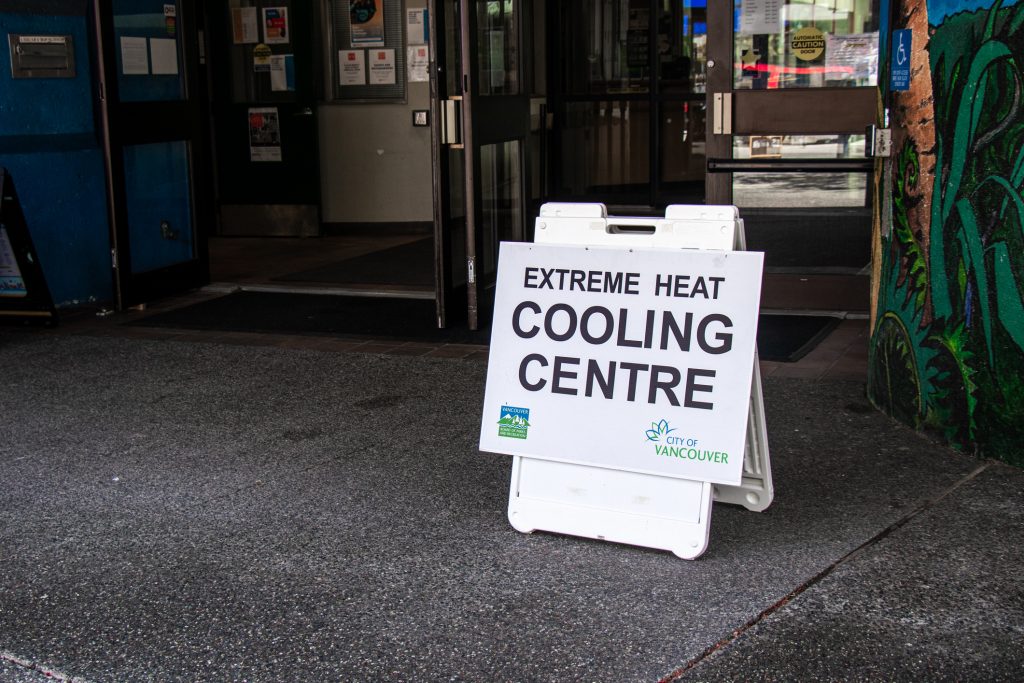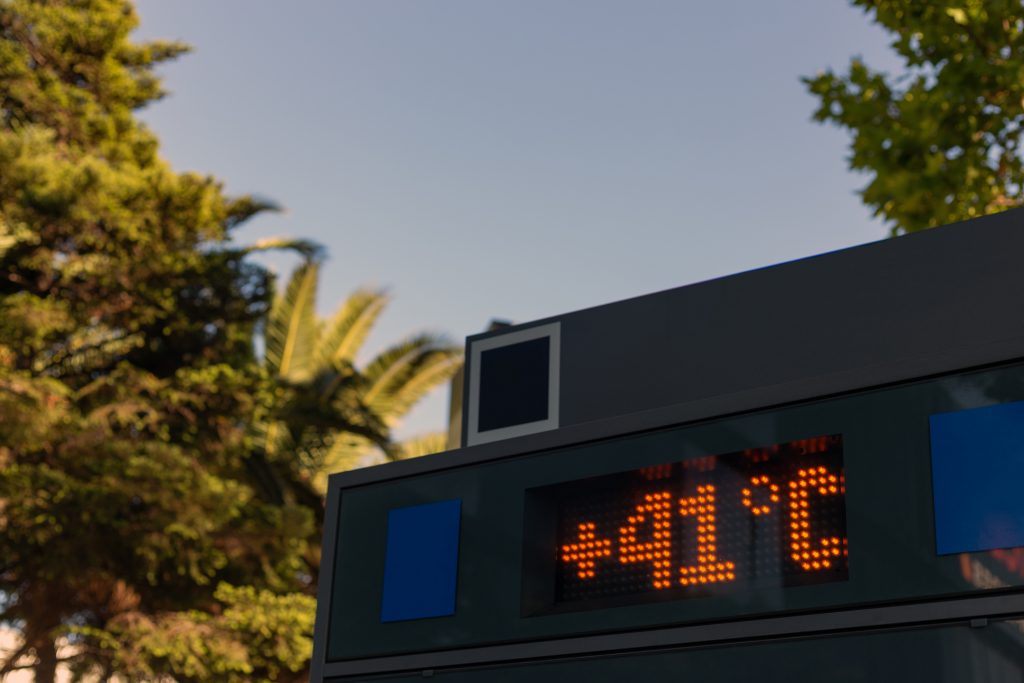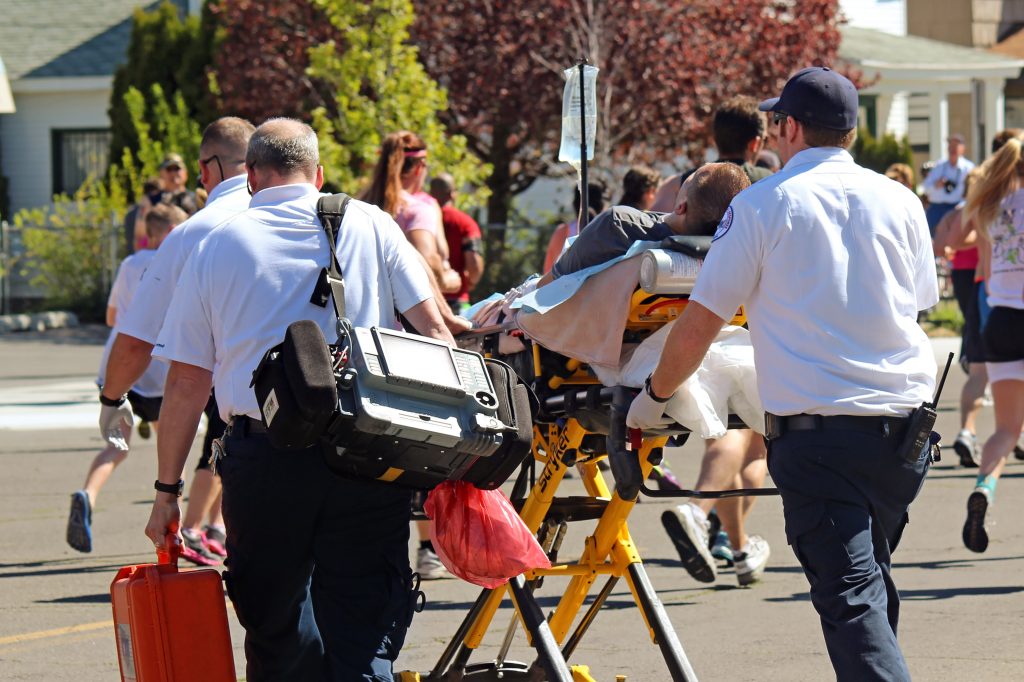by Alyssa Hill
Key messages:
- Across B.C., extreme heat events are becoming hotter, longer, and more frequent because of climate change.
- Without better planning, extreme heat will have deadly effects and increase infrastructure, food, and utility costs for governments and households.
- Health authorities, municipalities, regional districts, and Indigenous governments have an important role in heat preparedness, response, and longer-term planning.
Extreme heat is no longer a future threat to British Columbians — it’s already here, and it’s deadly. In 2021, B.C. experienced a deadly ‘heat dome’, which killed at least 619 people and significantly affected the health of thousands of others. Lytton, B.C. reached a record high temperature of 49.6°C on June 29, 2021, and burned to the ground the next day.
Local and regional governments and Indigenous Nations hold the power to better safeguard people in their communities. Below is the latest information on extreme heat, and what every decision maker needs to know to strengthen heat preparedness, response, and longer-term resilience.
Human-induced climate change is causing rapid warming. Canada is heating up about twice as fast as the rest of the world. Indeed, the annual average temperature has warmed about 2°C compared to the 1961 to 1990 period. The magnitude and frequency of temperature extremes is also changing. Extreme heat events are defined as a period where temperatures are unusually high for multiple days and nights in a row.

Climate change is making extreme heat events hotter, longer, and more frequent. For example, the 2021 heat dome would have been 150 times less likely without climate change. By 2030, B.C. could be dealing with ~6,000 heat-related hospitalizations per year and on average 1,370 heat-related deaths per year without adequate adaptation.
Photo credit: iStock/ Margarita-Young
Without more action to adapt and protect communities, extreme heat will continue to have widespread impacts on British Columbians.

Health: Extreme heat is a significant threat to physical and mental health. During the 2021 heat dome, over 619 people died from heat exposure and hundreds of people needed emergency medical care. Emergency services, the healthcare system, and other service providers were overwhelmed leading to fatal delays and inadequate care.

Economy and livelihoods: Extreme heat can threaten worker health and safety and decrease productivity. During the 2021 heat dome, numerous restaurants, factories, stores, offices, and schools closed. Across all sectors there was an estimated $205 to $328 million in lost income.

Homes and infrastructure: Many of B.C.’s homes, buildings, roads, hospitals, and electricity systems are not built for extreme heat. Only 32 per cent of homes have air conditioning (98 per cent of deaths during the 2021 heat dome occurred indoors). The heat dome also pushed infrastructure including power grids, health care equipment, and road, rail, and air transport to their limits. In some cases, this further complicated emergency response.

Ecosystems and food systems: Extreme heat negatively effects land and aquatic plants and animals. During the heat dome, livestock and shellfish perished, the quality of fruit and vegetables declined, and the timing, availability, and abundance of traditional food for Indigenous communities was affected.

Cascading and compounding effects: Extreme heat can lead to more dangerous wildfires and higher streamflow, water scarcity, and poor water quality. During the 2021 heat dome, the number of active fires in B.C. rose from six to 175. Research also shows that when extreme heat occurs at the same time as wildfire smoke (which is a reality in B.C.); the health impacts from simultaneous heat and smoke are worse than extreme heat alone.
Not everyone is affected by heat equally. Older adults, pregnant people, children, people with chronic diseases and mental health conditions, people with disabilities, and Indigenous and racialized people tend to experience worse health outcomes during extreme heat events. Workers in the agricultural sector (particularly migrant and temporary foreign workers), construction, and hospitality sectors also face increased exposure to heat.
During the 2021 heat dome, age, health status, income, and inadequate housing significantly affected people’s ability to stay cool. For example, low-income seniors who were socially isolated were among the highest mortality rates. In addition, people facing barriers such as poverty, language and literacy deficits, mental health challenges, substance use, lack of social networks, and lack of awareness of supports, experienced worse health effects.


Photo credits: iStock
Planning for extreme heat in your community
Health authorities, municipalities, regional districts, and Indigenous governments have a key role in heat preparedness, response, and longer-term resilience. Below are evidence-based actions to better protect communities from extreme heat:

Understand extreme heat in your community
Understanding extreme heat risk in your region can help shape and inform your response and long-term planning. Assessing extreme heat risk can include:
- Identifying which neighbourhoods get the hottest: Neighborhoods with more buildings, paved services, and areas with less green space have higher temperatures because of the urban heat island effect, whereas areas near water, parks, and with tree canopy have cooler temperatures.
- Identifying which buildings get the hottest: A building’s age, height, location, construction materials, insulation, and cooling system have huge effects on safety. Units without air conditioning, large windows facing south or west, and top floor units can put people at especially high risk of dangerous indoor temperatures (over 26°C).
- Identifying who is most vulnerable in your region and what is needed to reduce that vulnerability: Certain populations are more at-risk of negative health effects from heat and require targeted interventions.
You can assess extreme heat as part of your community’s Hazard, Risk, and Vulnerability Analysis, heat response plan, climate adaptation planning, or extreme heat mapping (e.g. Vancouver Coastal Health, Capital Regional District, North Shore Emergency Management, and the City of Vancouver). As you assess extreme heat and plan for response and long-term adaptation strategies, consider climate change data, extreme heat research, local and Indigenous Knowledges, and lived experiences from your community, particularly vulnerable populations or their service providers.

Be prepared to respond to extreme heat
Extreme heat events will happen more frequently over the next decade, even if global greenhouse gas emissions decrease substantially. Preparing to respond to extreme heat is key to saving lives and reducing costs. A heat response plan and/or emergency response plan are particularly useful tools for local decision makers. To be most effective, heat response plans should:
- Be tailored to local and regional context: Consider local strengths, local and Indigenous knowledges, and other hazards that you are planning for that can incorporate extreme heat.
- Empower community networks: Include a plan for mobilizing existing community partners and service providers (e.g. Indigenous housing providers, community organizers, faith-based groups, neighbourhood houses etc.). Wellness checks and interventions rooted in social connection and community care (especially for Indigenous communities) can save lives during a heat event.
- Include targeted strategies for vulnerable groups: Include a plan for activating available cooling infrastructure, resources, communications, and emergency responders in ways that are trauma-informed, equitable, and accessible. Consider a range of emergency cooling options in addition to cooling spaces (e.g. mobile units, cooling tents, misting stations, kits, and devices). Consider providing information in multiple languages, extended hours of operation for cooling spaces, and ensuring residents have affordable and accessible transportation during extreme heat events.
For specific guidance and effective examples of heat response plans, see the provincial heat alert response system, BC CDC guide for medium-sized municipalities, and the Interior Health toolkit.

Implement long-term heat resilience strategies
Communities in B.C. and around the world are entering a new reality of significantly warmer temperatures. Decision makers must plan and build communities that are resilient to extreme heat. While air conditioning is one of the most effective strategies for reducing the risk of heat-related illness and death, having an air conditioner or heat pump in every home in B.C. is not feasible, affordable, or sustainable in the long term.
Local, regional, and Indigenous governments will need to create holistic cooling strategies where everyone has access, knowledge, and means to stay cool at home, at work, and in their communities. Decision makers should consider:
- Education and awareness campaigns: Consistent and accessible public education about heat safety can support effective heat preparedness, response, and build the foundation for longer term resilience. The BC CDC, NCCEH, and BC health authorities including First Nations Health Authority have helpful resources.
- Create cooler indoor spaces: Updating policies (e.g. building codes and bylaws) can support maximum temperature limits and help bring cooling mechanisms (e.g. air conditioner or heat pump) into new and existing developments.
- Integrate cooling into community planning: Planners, particularly in cities, can create cooler communities through strategies like urban greening, passive cooling in urban design for new buildings or retrofits, and land use planning.
- Reduce disproportionate impacts: Broader poverty reduction and housing efforts (including stronger worker and tenant protections) can help reduce the disproportionate impacts of extreme heat.

Continue to coordinate and collaborate
It will take every order of government as well as community groups, researchers, and individuals to decrease the risks of extreme heat. Local and regional governments should continue to cooperate and share knowledge within and between jurisdictions to support more effective and coordinated action.
Research collaborations can support research gaps including improved collection of disaggregated data, better understanding of the health, ecosystem, and infrastructure impacts and costs of extreme heat, and information on the effectiveness of different response and adaptation strategies. If you are interested in learning more about extreme heat research or opportunities to collaborate, check out heat research groups and news from the following PICS universities:
- UBC: Environmental Health Research Team, Centre for Climate Justice, and Climate Equity Action and Resilience Project (CLEAR)
- UNBC: Department of Geography
References
Arefin, M. R., Novoa, F., Prada, L., Pratt, G., & Siu-Zmuidzinas, I. (2024). Migrant agricultural workers in British Columbia face compounding crises: housing and climate. The Centre for Climate Justice and Radical Action with Migrants in Agriculture. https://climatejustice.ubc.ca/wp-content/uploads/sites/45/2024/08/FINAL-RAMA-Report.pdf
BC Centre for Disease Control. (2025). BC Provincial Heat Alert and Response System (BC HARS): 2025. http://www.bccdc.ca/resource-gallery/Documents/Guidelines%20and%20Forms/Guidelines%20and%20Manuals/Health-Environment/Provincial-Heat-Alerting-Response-System.pdf
BC Coroners Service. (2022). Extreme heat death review panel: Heat-related deaths in B.C. during the heat dome of 2021. https://www2.gov.bc.ca/assets/gov/birth-adoption-death-marriage-and-divorce/deaths/coroners-service/death-review-panel/extreme_heat_death_review_panel_report.pdf
BC Green Care. (2020). Green design for climate resilience & well-being a better practice guide. https://bcgreencare.ca/wp-content/uploads/2021/10/Green-Design-for-Climate-Resilience-and-Well-being.pdf
BC Hydro. (2022). 2021: A record-breaking year for electricity demand and extreme weather. https://www.bchydro.com/content/dam/BCHydro/customer-portal/documents/news-and-features/2021-demand-report.pdf
Beugin, D., Clark, D., Miller, S., Ness, R., Pelai, R., & Wale, J. (2023). The case for adapting to extreme heat: Costs of the 2021 B.C. heat wave. Canadian Climate Institute. https://climateinstitute.ca/wp-content/uploads/2023/06/The-case-for-adapting-to-extreme-heat-costs-of-the-BC-heat-wave.pdf
Bush, E., Gillett, N., Watson, E., Fyfe, J., Vogel, F. & Swart, N. (2019). Understanding Observed Global Climate Change; Chapter 2 in Bush, E. and Lemmen, D. S. (Eds.) Canada’s Changing Climate Report (pp 25-72). Government of Canada. https://changingclimate.ca/CCCR2019/chapter/2-0/
Chenne, W., & Doyon, A. (2025). How are local governments planning for heat mitigation? A study of Metro Vancouver and Fraser Valley jurisdictions. Journal of Environmental Policy & Planning, 1–14. https://doi.org/10.1080/1523908X.2025.2480691
Clark, D. G., Jackson, E. H., Hohl, C. M., & Liang, K.E. (2024). Extreme heat impacts on acute care: Examining emergency department visits and hospital admissions during the 2021 British Columbia heatwave. The Journal of Climate Change and Health, 17(100310). https://doi.org/10.1016/j.joclim.2024.100310
Climate Atlas of Canada. (n.d.). Urban heat island effect. https://climateatlas.ca/urban-heat-island-effect
Coker, E. S., Cleland, S. E., McVea, D., Stafoggia, M. & Henderson, S. B. (2025). The synergistic effects of PM2.5 and high temperature on community mortality in British Columbia. npj Clean Air, 1(15). https://doi.org/10.1038/s44407-025-00014-9
Community Housing Transformation Centre & Aboriginal Housing Management Association (AHMA). (2023). Lived experience & stories of extreme heat among Indigenous households in British Columbia: Assessing the response from Indigenous housing providers and the Aboriginal Housing Management Association. https://ahma-bc.org/wp-content/uploads/2024/04/CNA-Report-Final.pdf
Clunas, C., & Shehwar, S. (2024, October 25). Building health capacity to safeguard communities from extreme heat. Climatedata.ca. https://climatedata.ca/building-health-capacity-to-safeguard-communities-from-extreme-heat/
Emergency Management BC. (2020). Hazard, risk and vulnerability analysis (HRVA) for local authorities and First Nations. https://www2.gov.bc.ca/assets/gov/public-safety-and-emergency-services/emergency-preparedness-response-recovery/local-government/hrva/guides/companion_guide_to_the_hrva.pdf
Government of British Columbia. (2022). Extreme heat: Preparedness for provincial ministries and agencies. https://www2.gov.bc.ca/assets/gov/public-safety-and-emergency-services/emergency-preparedness-response-recovery/provincial-emergency-planning/extreme_heat_preparedness_for_ministries_and_agencies.pdf
Government of British Columbia. (2024, April 19). Protection from overheating in dwelling units. https://www2.gov.bc.ca/assets/gov/farming-natural-resources-and-industry/construction-industry/building-codes-and-standards/bulletins/2024-code/b24-08_overheating.pdf
Government of British Columbia. (2025). Extreme heat preparedness guide. https://www2.gov.bc.ca/assets/gov/public-safety-and-emergency-services/emergency-preparedness-response-recovery/embc/preparedbc/preparedbc-guides/preparedbc_extreme_heat_guide.pdf
Government of British Columbia. (2025, June 18). Create and maintain an emergency plan. https://www2.gov.bc.ca/gov/content/safety/emergency-management/local-emergency-programs/establishing-an-emergency-program
Ladd, K. & Meerow, S. (2022). Planning for urban heat resilience. American Planning Association. https://planning-org-uploaded-media.s3.amazonaws.com/publication/download_pdf/PAS-Report-600-r1.pdf
Lee, M. J., McLean, K. E., Kuo, M., Richardson, G. R., Henderson, S. B. (2023). Chronic Diseases Associated with Mortality in British Columbia, Canada During the 2021 Western North America Extreme Heat Event. GeoHealth, 7, e2022GH000729. https://doi.org/10.1029/2022GH000729
Lee, M. & Parfitt, B. (2022). A climate reckoning: The economic costs of BC’s extreme weather in 2021. Canadian Centre for Policy Alternatives. https://policyalternatives.ca/sites/default/files/uploads/publications/BC%20Office/2022/11/ccpa-bc_Climate-Reckoning_web.pdf
Lindsay, B. (2023, June 29). Summer now means fear for some, as study shows poverty brought biggest risk of death in B.C. heat dome. CBC News. https://www.cbc.ca/news/health/bc-heat-dome-poverty-connection-1.6891461
Lubik, A., McKee, G., Chen, T., & Kosatsky, T. (2017). Municipal heat response planning in British Columba, Canada. Prepared for BC Centre for Disease Control. http://www.bccdc.ca/resource-gallery/Documents/Guidelines%20and%20Forms/Guidelines%20and%20Manuals/Health-Environment/BC%20Municipal%20Heat%20Response%20Planning.pdf
Kenny, G. P., Flouris, A. D., Yagouti, A., & Notley, S. R. (2018). Towards establishing evidence-based guidelines on maximum indoor temperatures during hot weather in temperate continental climates. Temperature (Austin, Tex.), 6(1), 11–36. https://doi.org/10.1080/23328940.2018.1456257
Kenny, G. P., Tetzlaff, E. J., Journeay, W. S., Henderson, S. B., & O’Connor, F. K. (2024). Indoor overheating: A review of vulnerabilities, causes, and strategies to prevent adverse human health outcomes during extreme heat events. Temperature, 11(3), 203–246. https://doi.org/10.1080/23328940.2024.2361223
Michell, P. (2023, June 12). Hope flows from action: Rebuilding with resilient foundations in B.C.’s Fraser Canyon Region. Canadian Climate Institute. https://climateinstitute.ca/publications/hope-flows-from-action-rebuilding-with-resilient-foundations-fraser-canyon-region/
Ministry of Environment and Climate Change Strategy. (2019). Preliminary strategic climate risk assessment for British Columbia. https://www2.gov.bc.ca/assets/gov/environment/climate-change/adaptation/prelim-strat-climate-risk-assessment.pdf
National Collaborating Centre for Environmental Health. (n.d.). Health checks during extreme heat events: A guide for doing in-person or remote health checks. https://ncceh.ca/sites/default/files/NCCEH%20Extreme%20Heat%20Event%20-%20Health%20Checklist%20WEB_0.pdf
Philip, S. Y., Kew, S. F., Van Oldenborgh, G. J., Anslow, F. S., Seneviratne, S. I., Vautard, R., Coumou, D., Ebi, K. L., Arrighi, J., Singh, R., Van Aalst, M., Pereira Marghidan, C., Wehner, M., Yang, W., Li, S., Schumacher, D. L., Hauser, M., Bonnet, R., Luu, L. N., Otto, F. E. L. (2022). Rapid attribution analysis of the extraordinary heat wave on the Pacific coast of the US and Canada in June 2021. Earth System Dynamics, 13(4), 1689–1713. https://doi.org/10.5194/esd-13-1689-2022
Plater, T. & MacDonald, R. J. (2024). Unhoused under pressure: Climate change and homelessness in Vancouver’s Downtown Eastside. Union Gospel Mission & University of British Columbia Sustainability Hub. https://ugm.ca/sites/default/files/2024-06/ClimateChangeHomelessness_2024_Digital_1.pdf
Quick, M., & Tjepkema, M. (2023). The prevalence of household air conditioning in Canada. Statistics Canada. https://www.doi.org/10.25318/82-003-x202300700002-eng
SHIFT Collaborative. (2023). Heat response planning for Southern Interior B.C. communities: A toolkit. Prepared for Interior Health. https://www.interiorhealth.ca/sites/default/files/PDFS/heat-alert-response-planning-toolkit.pdf
SHIFT Collaborative. (2024). Climate change and health in British Columbia: From risk to resilience. Ronald, L. & Klein, K. (Eds). Prepared for the B.C. Ministry of Health, Victoria, British Columbia. https://nrs.objectstore.gov.bc.ca/xedyjn/Projects/2023/ClimateReadyBC/page_health_r2r/Final.pdf
Smith, S. (2025, April 22). Prepare today to save lives tomorrow: SFU study finds gaps in B.C. extreme heat response plans. Simon Fraser University. https://www.sfu.ca/sfunews/stories/2025/04/prepare-today-to-save-lives-tomorrow–sfu-study-finds-gaps-in-b-.html
Tetzlaff, E. J., Goulet, N., Gorman, M., Ioannou, L. G., & Kenny, G. P. (2023). Working under the 2021 Heat Dome: A content analysis of occupational impacts mentioned in the Canadian media. Healthcare, 11(17), 2423. https://doi.org/10.3390/healthcare11172423
Vancouver Coastal Health. (2023). Creating cooling spaces during hot weather: guidance for community organizations. https://www.vch.ca/en/media/19776
Vancouver Coastal Health. (2023). Policy tools to create and support cooler, safer indoor living spaces. https://www.fraserhealth.ca/-/media/Project/FraserHealth/FraserHealth/Health-Topics/Sun-and-heat-safety/Policy-Tools-Cooler-Spaces.pdf
Vancouver Coastal Health. (2023). Protecting population health in a climate emergency. https://www.vch.ca/sites/default/files/2024-02/vch-climate-change-health-report.pdf?utm_source=vancouver%20is%20awesome&utm_campaign=vancouver%20is%20awesome%3A%20outbound&utm_medium=referral
White, R. H., Anderson, S., Booth, J. F., Braich, G., Draeger, C., Fei, C., Harley, C. D. G., Henderson, S. B., Jakob, M., Lau, C. A., Mareshet Admasu, L., Narinesingh, V., Rodell, C., Roocroft, E., Weinberger, K. R., & West, G. (2023). The unprecedented Pacific Northwest heatwave of June 2021. Nature Communications, 14(1). https://doi.org/10.1038/s41467-023-36289-3
Worker Solidarity Network. (2023). Climate and labour report 2023. https://workersolidarity.ca/wp-content/uploads/2023/05/Climate-and-Labour-Report-WSN-2023.pdf
Yoon, L., Arefin, M.R., Jewell, K., & Pratt, G. (2025). Too Hot to Think Small: The Case for a Right to Cool in British Columbia. University of British Columbia (UBC) Centre for Climate Justice. https://climatejustice.ubc.ca/projects-and-partnerships/too-hot-to-think-small-the-case-for-a-right-to-cool-in-british-columbia/
Yumagulova, L., Dicken, E., Michell, P., Lysons, S., Gabriel, C., & Carpenter, R. (2023). Community is the solution. Canadian Climate Institute. https://climateinstitute.ca/publications/community-solution-2021-extreme-heat-emergency-experience-british-columbia-first-nations/#discussion-recommendations
Yumagulova, L., Okamoto, T., Crawford, E., Klein, K. (2023). Lived experience of extreme heat in B.C.: Final report. https://www2.gov.bc.ca/assets/gov/environment/climate-change/adaptation/resources/lived_experience_of_extreme_heat_in_bc_final_report.pdf
Zhang, X., Flato, G., Kirchmeier-Young, M., Vincent, L., Wan, H., Wang, X., Rong, R., Fyfe, J., Li, G., Kharin, V.V. (2019). Changes in Temperature and Precipitation Across Canada; Chapter 4 in Bush, E. and Lemmen, D.S. (Eds.) Canada’s Changing Climate Report (pp 112-193). Government of Canada.
Alyssa Hill is a project analyst with the Pacific Institute for Climate Solutions.
